Confidentiality notice: This case study is based on my work as the Ahua Design System Lead at Yara. Due to confidentiality agreements, certain details and proprietary assets have been generalized or omitted. The views expressed are my own and do not represent Yara’s official position.
Challenge
Feeding the world while protecting the planet
Today, 4 billion people depend on food grown with fertilizers – yet the ag industry must drastically reduce greenhouse gas emissions to mitigate the climate crisis.
For Yara International, a global crop nutrition leader helping feed 262 million people, digital transformation is critical to stay relevant.
The mission: Drive sustainable farming practices, helping farmers grow more food with less fertilizer while improving their livelihoods.
Digital context
Yara International is a global leader in crop nutrition, operating in over 60 countries through regional and central business units, including Yara Asia & Africa, Yara Europe, Yara Americas, Digital & Innovation, and Corporate Development.
Yara’s digital products support millions of farmers worldwide in growing more food with fewer emissions.
Ahua Design System supports this mission by increasing efficiency, reducing design and development waste, enabling knowledge sharing, and improving quality and consistency across the digital ecosystem.
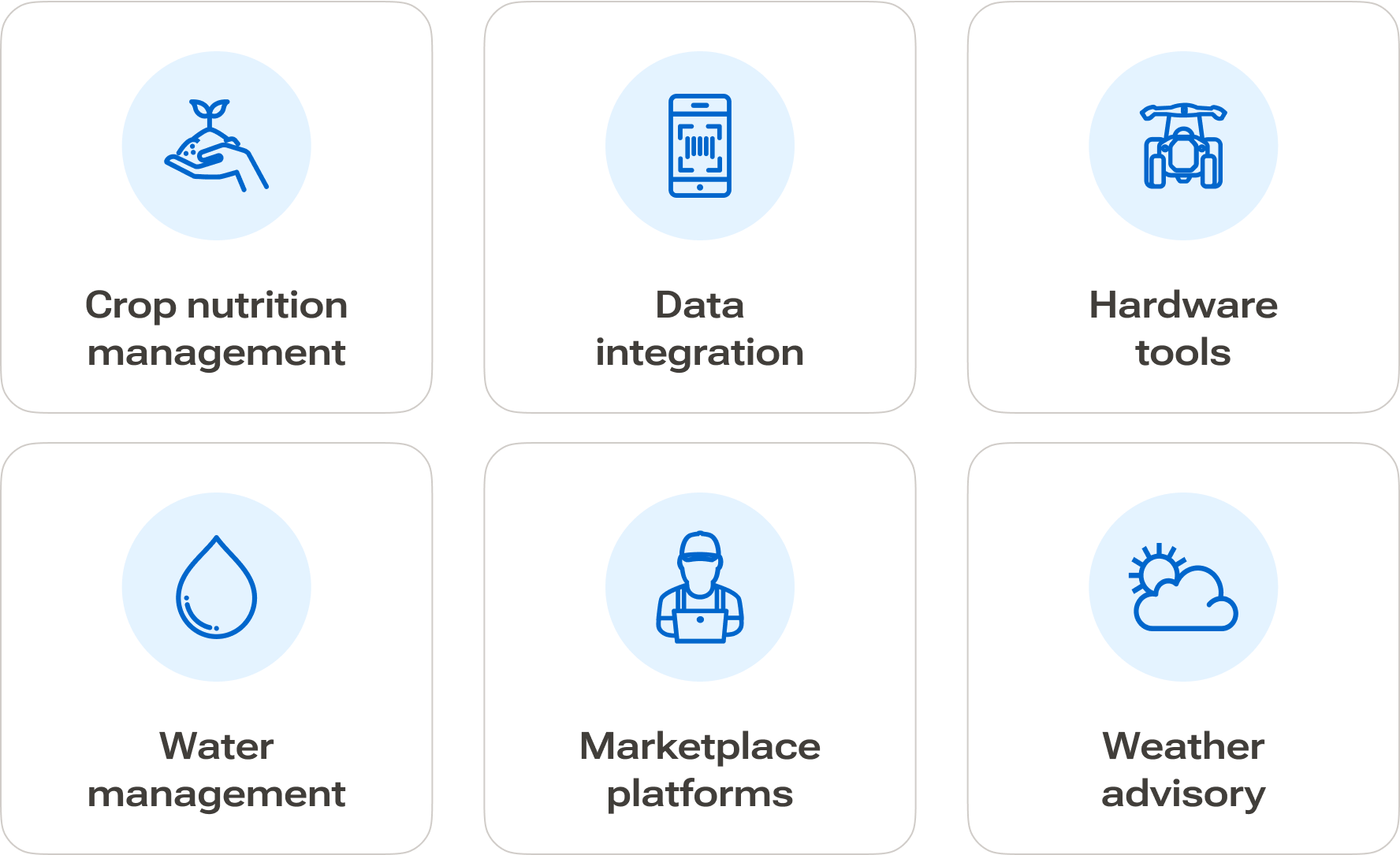
Design challenge
Designing for global markets
The need for a unified design system emerged as digital teams across regions explored various solutions for local markets. This rapid growth presented several challenges:
Complex landscape
Yara operates in over 60 countries, serving diverse user segments from enterprise clients to smallholder farmers. Products needed to support multiple languages and work across various platforms, creating an intricate matrix of requirements.
Fragmented infastructure
Without common digital practices or central governance, regional independence led to divergent solutions. Teams operated with different processes, tools, and standards, while legacy systems further complicated integration efforts.
Timeline
"A complex system that works is invariably found to have evolved from a simple system that worked." – Gall's law
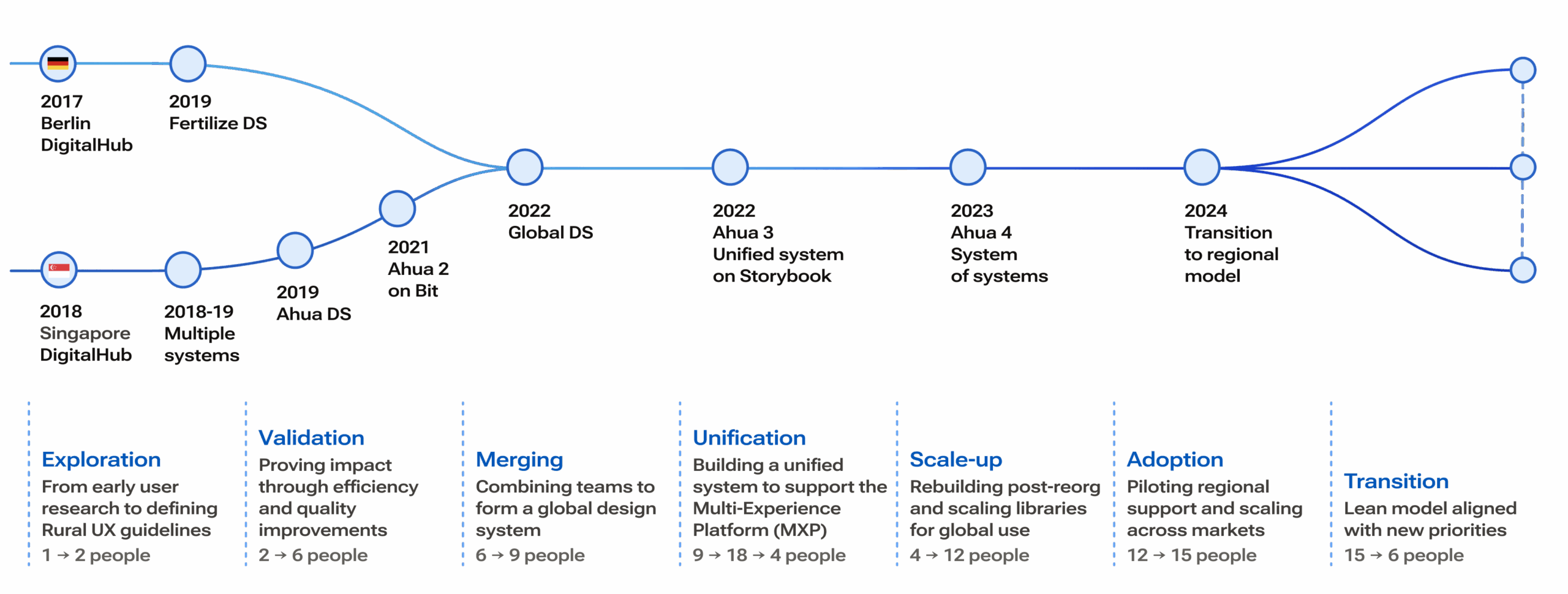
The Ahua design system reflects this principle of evolutionary development. What began as a Good Harvest UI Kit—a small system supporting solutions in early digital initiatives—has grown into a robust global design infrastructure. I led multiple team iterations, growing the cross-functional team from an initial 2 to 15 during its peak.
Overview
Ahua in numbers
Ahua is one of Yara’s most successful internal products. It supports diverse use cases—from agtech platforms to commercial apps, enterprise solutions, data marketplaces, and sustainability tools—making it a flexible, scalable foundation of Yara’s product ecosystem.
$6M
Estimated ROI
25+
Products, MVPs, POCs
180+
Components
50+
Teams supported
90+
Active users
10M
Inserts
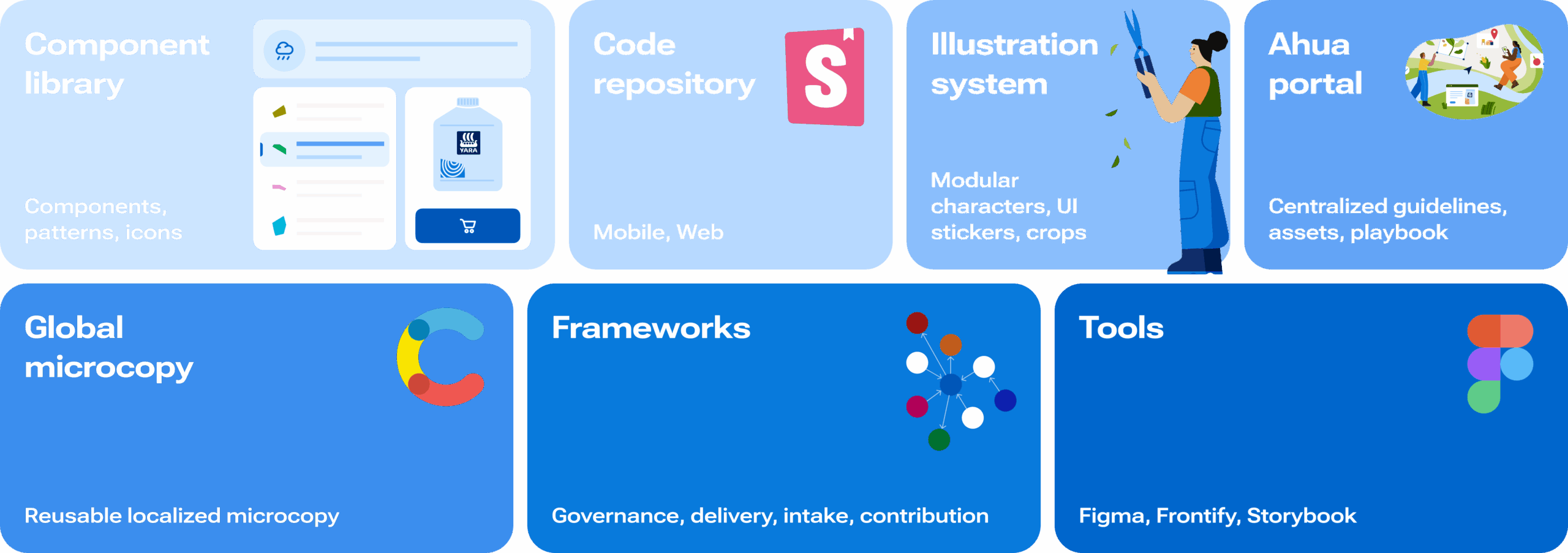
Overview
Ahua component library
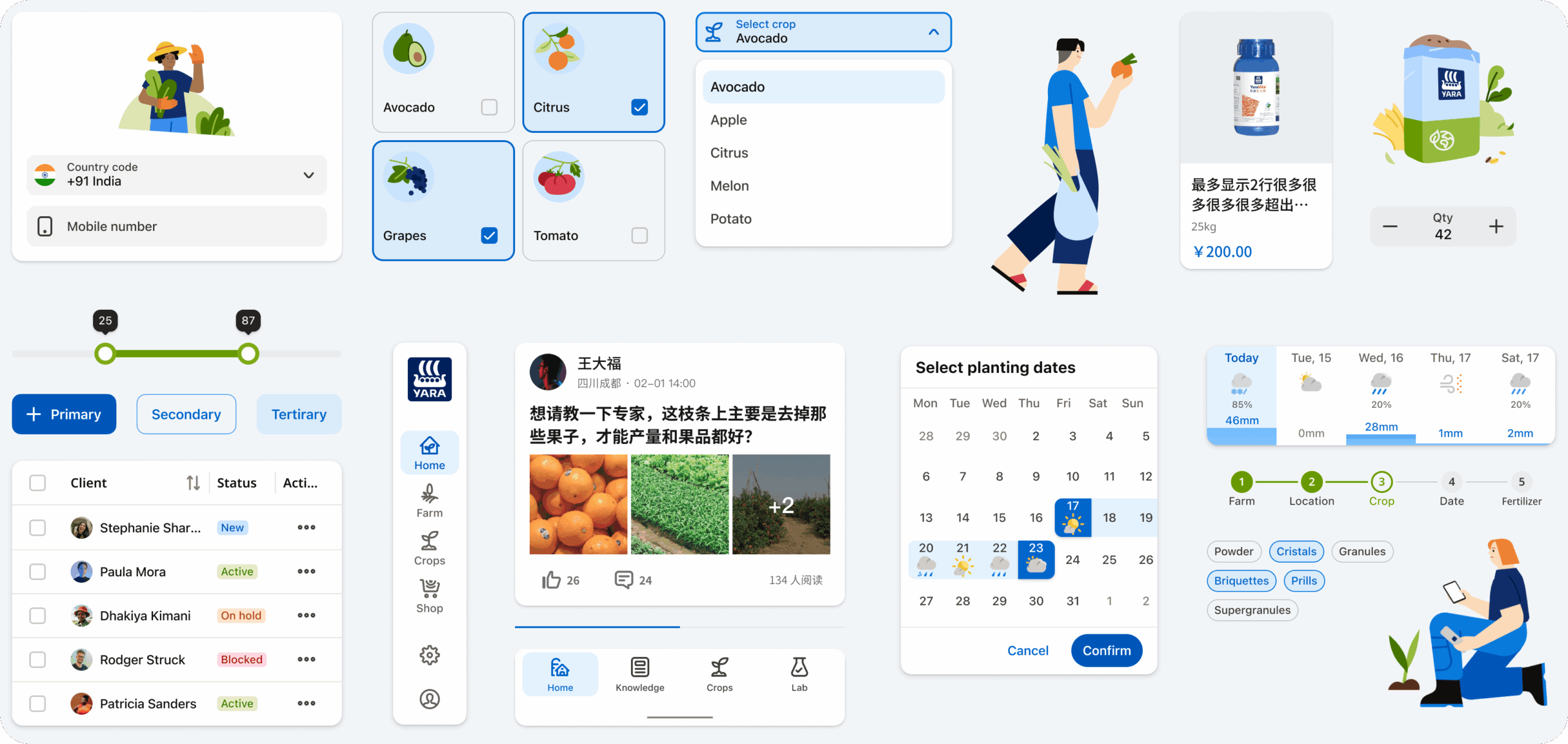
Recipe of success
Ahua's success is rooted in 3 key dimensions: Creating a collaborative culture that helps people deliver outstanding work, establishing a scalable platform architecture, setting up robust processes, and implementing efficient delivery that balances speed with quality.
People
Taking inspiration from the Kitchen Brigade model, we fostered a culture of excellence and collaboration that could enable rapid decision-making.
Platform
Building a scalable system that could support both global consistency and regional flexibility required evolving to a system of systems architecture.
Process
We adopted the Triple Diamond framework to address both market requirements and technical challenges while maintaining quality.
People
Org design for design system org
"Design systems are people." — Brad Frost
Design systems are about people. Taking inspiration from the Kitchen Brigade, we built an organization that could scale naturally while maintaining efficiency. After multiple iterations, we created a model that proved particularly effective during our growth from 2 to 15 team members, adopting lean project management practices.
Approach
- Lean leadership model
- Cross-functional empowered teams
- Distributed decision-making
- Asynchronous workflows
- AI-enhanced operations
Impact
- More efficient decision-making
- Reduced management overhead
- Enhanced team autonomy
- Better cross-regional collaboration
- Faster delivery cycles
Nurturing high-performance team
Design systems require a unique blend of skills that traditional product design roles often don't fully cover. Rather than seeking unicorns who excel at everything, we embraced the T-shaped talent model, recruiting specialists with depth in key areas while maintaining enough breadth to collaborate effectively.
Ahua team was structured around complementary profiles: DS Architect, Technical Designer, DS Advocate, DS Support, UX Engineer, UI Designer, and Illustrator, which allowed us to address specialized needs and broader system challenges. The overlap in skills created resilience and flexibility, enabling team members to collaborate effectively across time zones and support each other during peak delivery periods.
Growing talent
For a company like Yara, finding specialists with design system expertise presented a challenge. The solution that helped us address this gap was a focused internship program.
Ahua internship program ran during two seasons in 2020-22. It connected eight UX engineering graduates from Singapore, Hong Kong, and Germany with system-focused projects that allowed for exploration without immediate business pressure. This gave us room to investigate areas like computational colors, microinteractions, microcopy, and variable fonts while students gained valuable experience.
The approach worked well for both sides. We benefited from fresh perspectives and innovative solutions, and two interns joined the team full-time.
LCH colors were implemented in the system.
Variable fonts support helped to reduce app size while allowing for dynamic platform adaptations.
Microcopy project became the foundation of Ahua's global microcopy library.
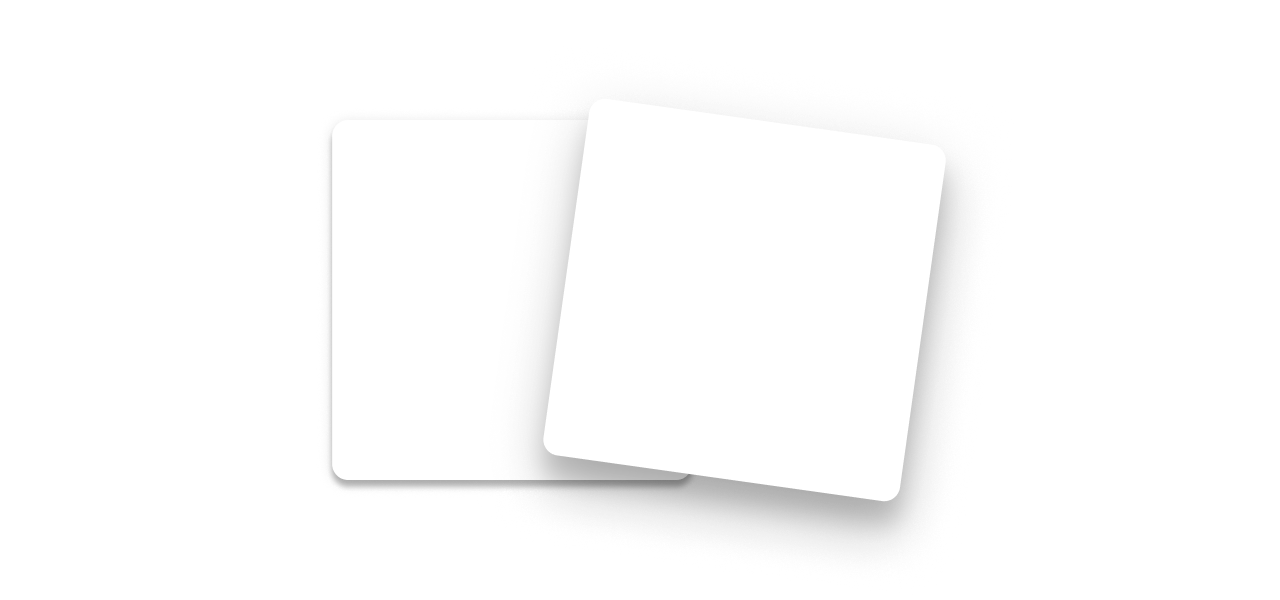
Tokenized microinteractions and transition patterns planned in future releases.
Platform evolution
From monolith to a system of systems
Balancing global standards with local needs
Serving regions with vastly different needs—from B2B enterprise solutions to B2C farmer apps to internal tools—required us to evolve architecture beyond a monolithic approach.
Adopting the system of systems model helped to establish a foundation for multiple context-specific subsystems, enabling regional flexibility while maintaining architectural consistency.
While the full-scale implementation is in the works, this approach proved to be viable as regions gained independence in their digital strategies, allowing teams to adapt while leveraging shared infrastructure.
Process
Ensuring quality and speed in a distributed environment
"Trust the process." — Ryan Flynn
Building a robust design system for a global organization like Yara required us to adopt a process that could handle both market and platform requirements and technical complexity while maintaining velocity. After some experimentation and tweaking, we operationalized the Triple Diamond model for the design system context.
The design system must evolve methodically to maintain a dependable foundation for many teams, account for various platforms and edge cases, and implement accessibility and internationalization. This model worked incredibly well to align expectations and develop a steady delivery pace.
Delivery
Scaling agile while staying lean
Adapting Large-Scale Scrum (LeSS)
Classic Scrum wasn't enough for our distributed team to work across multiple tracks: Component design, React, React Native, illustration system, content, regional support, and DS portal.
We needed an approach to maintain velocity while coordinating team members across Singapore, India, and Europe. To facilitate multi-stream delivery, we adapted Large-Scale Scrum (LeSS).
This approach enabled us to maintain efficiency and quality while coordinating complex work across time zones and disciplines — critical for a globally distributed design system team. Using AI project management tools like Spinach freed us from the need to have a dedicated scrum master and product owner – roles I took over
Adoption
Creating a living system
"If you build it, they wont' come." — Unknown
Design systems live and die by their adoption. Building Ahua was only half the challenge – ensuring its adoption across a diverse global organization required creating a living design system community.
Our adoption strategy followed a layered pyramid approach:
- Access — Switching to Figma Enterprise gave everyone in Yara access to our libraries.
Usage — A single source of truth was crucial. We started with Zeroheight before moving to Frontify and tried various approaches to improving team mastery.
Contribution — As the company's org structure evolved, we switched to the regional support model to maintain quality while providing enough flexibility for regional teams.
Evolution — The system had to evolve to meet growing customers' needs. Prioritization is a balancing act, as we discovered when implementing a structured intake process.
Impact — Our approach was to show business value through faster development, higher quality, and better collaboration.
This approach turned Ahua from "just another tool" into an essential part of Yara's digital ecosystem, with 80% of teams actively using it daily.
Impact
Measuring success
"You can't improve what you don't measure." – Peter Drucker (allegedly)
While Ahua became one of Yara's most widely adopted products, its true value extended beyond metrics to systematic design thinking, improved collaboration, and organizational design maturity.
Our measurement approach evolved with business needs, following a "Just Enough Metrics" philosophy that balanced comprehensive tracking with practical implementation:
Design adoption: Monitored through Figma analytics, achieving 10M component inserts across 120 teams
Code adoption: Tracked via Omlet analytics
Quality: Assessed through regular design audits
User satisfaction: Gathered via team surveys, workshops, and pigeon posts
This balanced measurement strategy helped us demonstrate business value while guiding continuous improvement.

Quantitative indicators
⟐ Adoption rate (% of product teams using Ahua)
⟐ Time to resolution (Request resolution)
⟐ Training completion rate (% of trained members)
⟐ Tool & platform usage (Utilization rate)
Qualitative indicators
⟐ Consistency score (Unified product experiences)
⟐ Evolution velocity (Pace of improvements)
⟐ User satisfaction (Feedback from product teams)
⟐ Design quality (Quality improvement)
Business value
Calculating ROI
One of the prerequisites of the Capital Value Process that I drove to secure funding for the Ahua scale-up was measuring the global design system's total ROI.
Traditionally, design system ROI calculations have focused solely on efficiency. However, this approach has limitations, especially when capturing the total value of a design system, which offers numerous qualitative benefits beyond time savings. We developed an improved formula that measures the system's value holistically:
ROI = (Time Savings + Quality Improvements + Collaboration Benefits - Costs) / Costs × 100
This formula allowed us to holistically account for all main benefits, such as increased efficiency (+30%), improved quality (+20%), and better team collaboration (+15%).
Using this approach, we estimated the ROI of the Ahua Design System at $6M USD over 3 years, accounting for the ramp-up and adoption period, when benefits increase gradually. True value is realized once the system is fully operational and adopted across teams.
The Design System Efficiency Curve,
Callahan (2021)
Outcome and impact
“Driving the train doesn't set its course. The real job is laying the track.” — Ed Catmull, Pixar
50+
Teams supported
80%
Adoption rate
$6M
Estimated 3-years ROI
Beyond metrics, Ahua evolved from a component library into a strategic design infrastructure, enabling teams across 60+ countries to create consistent and inclusive solutions for industrial and smallholder farmers.
The journey forward
The success of the Ahua design system represents the dedication of many collaborators across Yara, united by the mission of building a climate-positive food future.
From its humble origins as the Good Harvest UI kit to becoming a global design system, Ahua embodies Yara's collaborative spirit through culturally-sensitive, inclusive design principles.
As Yara continues its sustainability journey, Ahua will evolve to provide a robust foundation that enables innovation at scale while maintaining global consistency.